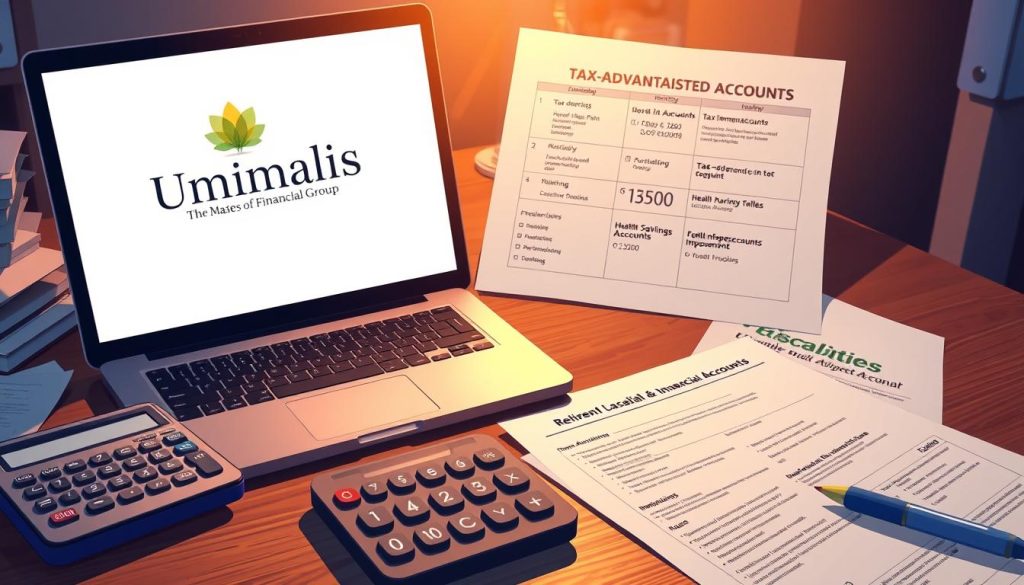Did you know that many independent professionals in France keep a noticeably larger share of their income each year by making a few simple choices in bookkeeping and spending?
We guide you through practical steps to lower your taxes and improve cash flow. Clear records, timely receipts, and smart expense tracking can change how much money stays in your account.
Our approach turns complex rules into clear information. You will learn which deductible expenses to track, how the timing of payments affects your annual return, and when to seek tax advice.
For a deeper look at declaration duties and eligible deductions in France, see our detailed guide on filing your declaration. This helps you balance short‑term savings with long‑term stability.
Table of Contents
Key Takeaways
- Organize invoices and record expenses to support your claims.
- Align spending and investments to improve yearly savings.
- Understand which deductions lower the taxable amount on your return.
- Keep a dedicated account and clear bookkeeping for peace of mind.
- Seek timely tax advice to avoid errors and protect your money.
Why Tax Benefits Matter When You’re Self‑Employed in France
As an independent professional, the timing of income and spending shapes what you ultimately keep.
Your record keeping now influences withholding, contributions, and yearly returns. You file a business‑oriented tax return that shows revenue, allowable deductions, and deductible expenses. Clear records reduce friction when authorities review your position.
Managing fees and social contributions is part of the job. By choosing when to pay certain costs, you can smooth cash flow across the year and limit additional tax exposure.
- Track which expenses are deductible and how to book them over time.
- Align investments and professional fees with projected income.
- Keep supporting information and precise details for each item.
| Area | What to record | Why it matters |
|---|---|---|
| Revenue | Invoices, dates, client names | Determines declared income and return accuracy |
| Expenses | Receipts, purpose, period | Supports deductions and lowers taxable base |
| Contributions & Fees | Statements and payment dates | Helps time payments to optimize cash flow |
Understanding Tax Advantages
A clear view of deductions, credits, exclusions and losses makes planning simpler and more predictable.
What each mechanism does:
- Deduction — lowers the amount of income that is subject to tax by subtracting eligible costs from your gross income.
- Credit — reduces the tax bill euro for euro and usually requires specific forms or documentation.
- Exclusion — keeps certain receipts out of taxable income when you meet strict eligibility rules.
- Capital loss — offsets gains first; excess losses can be carried forward under standard schedules.
Immediate savings typically come from deductions and credits you claim on the current return.
Long‑term savings emerge when you time exclusions and investment moves across the year to match your expected rate and income.
« Plan the timing of major purchases and investments to align with your projected income; small shifts in time can change the amount you keep. »
Practical steps: collect supporting information early, keep clear details by category, and decide if a year‑end purchase should be accelerated or deferred to match your bracket.
For more detailed guidance on planning through the year, see our note on optimisation fiscale.
| Mechanism | Immediate effect | Planning tip |
|---|---|---|
| Deduction | Reduces taxable income | Document eligible expenses promptly |
| Credit | Cuts the tax bill directly | Check qualifying rules and forms |
| Exclusion | Removes income from base | Confirm eligibility before reporting |
| Capital loss | Offsets gains, may carry forward | Track investment results and schedules |
Deductible Business Expenses That Lower Your Taxable Income
Knowing which business costs qualify and how to record them makes year‑end filings far simpler. We outline common items and the proof you must keep so your position is defensible.

Common deductible items
Professional fees, specialized equipment, mileage tied to client visits, a portion of a dedicated home office, and business interest can all reduce your taxable income when they meet local rules.
Keep a dedicated business account or savings account to separate transactions. This clarifies the amount spent on work and protects you if authorities request proof.
Proof and documentation
Retain invoices, receipts and account statements. Match each payment to a category and record the date, purpose and amount. For mileage, log date, origin, destination and distance contemporaneously.
- Store itemized receipts and contracts for fees and services.
- Keep loan statements showing interest tied to business borrowing.
- Document exclusive use for home office deduction criteria.
| Expense | Proof to keep | Why it matters |
|---|---|---|
| Equipment | Invoice, payment record | Supports deduction on your return |
| Mileage | Trip log, fuel receipts | Justifies claimed amount |
| Interest & fees | Bank statements, contracts | Shows business purpose |
« Regular reviews each quarter keep records complete and reduce surprises at filing. »
Credits and Exclusions: Direct Reductions vs. Income You Don’t Pay Tax On
Some mechanisms reduce your final bill directly; others keep certain receipts from entering the taxable base at all. Both routes change what you ultimately pay on your annual return.
How a credit can cut your tax bill dollar‑for‑dollar
A credit reduces the amount you owe euro‑for‑euro. It usually needs a specific form or calculation and supporting documents.
Keep clear evidence of eligible costs and follow the form rules to claim the full amount. Credits give immediate relief when you file your return.
Exclusions: classifying certain income so it doesn’t enter your tax base
An exclusion treats qualifying income as tax‑free. When conditions are met, that income never enters the base used to compute taxes.
Exclusions often have strict eligibility criteria. Keep precise information and a checklist to show why an item is excluded.
- Credits cut your bill directly; deductions lower income first.
- Exclusions remove income so you never pay on that category.
- Map credits and exclusions across your projects to estimate the amount you can claim each year.
- Maintain a simple file of documents so you claim benefits confidently and answer post‑filing questions.
« Pair the right relief with the right income, and you protect more of your revenue without stretching the rules. »
| Mechanism | Immediate effect | Record to keep |
|---|---|---|
| Credit | Reduces final bill | Forms, invoices, calculations |
| Exclusion | Removes income from base | Eligibility proof, contracts |
| Deduction | Lowers taxable income | Receipts, logs |
Capital Losses and Investment Moves to Reduce Income Tax
Prudent portfolio moves let you match losses against gains to reduce what you pay at year end. This approach can lower the impact of profitable sales on your annual return without changing your long‑term plan.
Offsetting gains with losses
Capital losses can offset capital gains in the same fiscal year. Doing so reduces the amount of income subject to levy from profitable disposals.
Example: realise a modest loss to offset a concentrated gain and lower the final amount reported on your return. Timing matters: sell the loss and the gain within the same year to capture the effect.
Carryforwards: using excess losses later
If losses exceed gains, a portion may be deductible each year and the rest carried forward. Maintain a standard schedule of gains and losses in your records to track carried balances.
- Plan disposals to match your cash needs and target rate.
- Keep acquisition and sale dates, proceeds, costs, and fees for every transaction.
- Use losses to smooth the return impact, but let your investment policy remain primary.
« Thoughtful loss harvesting protects liquidity while improving after‑cost returns. »
| Action | Immediate effect | Record required |
|---|---|---|
| Realise loss | Offsets gains in same year | Trade confirmation, dates, costs |
| Excess loss | Carryforward to future years | Annual loss schedule, supporting trades |
| Timed sale | Aligns rate and cash needs | Plan notes, projected return impact |
Tax‑Advantaged Accounts and Plans: Tax‑Deferred, Tax‑Free, and Immediate Deductions
Your choice of account determines whether growth is taxed now, later, or not at all. We group common vehicles into three clear categories so you can match a plan to your horizon and cash needs.
Tax‑deferred growth
How it works: earnings compound inside the account and are taxed when withdrawn. This can lower your rate if your future bracket is smaller.
Tax‑free growth
How it works: qualified withdrawals of earnings are exempt from levy. Use these accounts for long‑term savings tied to specific goals.
Immediate deductions
How it works: contributions reduce your current‑year taxable base. That offers immediate relief but may constrain access later.
Watch contribution limits and early‑withdrawal penalties. Maintain a separate account for each purpose to track contributions and earnings clearly.

| Category | Primary benefit | Key rule to watch |
|---|---|---|
| Tax‑deferred | Delay tax on earnings | Withdrawals taxed at withdrawal rate |
| Tax‑free | Qualified withdrawals untaxed | Strict eligibility and qualified expenses |
| Immediate deduction | Reduce current‑year taxable base | Contribution limits and possible penalties |
« Match the account to your liquidity needs, expected rate at withdrawal, and investment horizon. »
For more information on how timing affects reported income, see our note on income implications.
Education Savings Insights: How Savings Plans Can Deliver Tax Benefits
Education savings plans let you build a dedicated pot for future study while keeping growth sheltered until funds are needed.
Tax‑deferred growth in many plans means earnings compound without immediate levy, and withdrawals used for qualified expenses—tuition, approved fees, and materials—are often tax‑free. This makes these vehicles practical for college and other student needs.
State rules and residency
Some jurisdictions offer state‑level deductions for contributions. Residency and plan rules determine the allowed deduction and the amount you may claim. Check local information before funding an account.
Gift and estate planning
Front‑loading contributions can accelerate funding and reduce estate exposure. Accelerated gifting rules let you place several years’ worth of savings into one account, but non‑qualified withdrawals may trigger income taxes and penalties on earnings.
- Keep receipts and clear records of qualified expenses for each beneficiary.
- Use separate accounts or sub‑accounts to track the amount allocated to each student.
- Align plan selection with your purposes, paperwork capacity, and appetite for administration.
« Organised accounts and timely documentation preserve plan features and reduce filing friction. »
tax advantages You Can Plan Around All Year
A simple calendar that links receipts and forecasts keeps surprises off your year‑end return. Plan reviews each quarter so you can act on expected income and planned expenses, not react to them.
Quarterly planning: aligning income, expenses, and investments with your tax rate
Every quarter, review projected income and map it to planned spending and investments. This practice helps you match your expected rate and decide when to accelerate or defer items.
Schedule short sessions to update forecasts and note any changes in revenue or fees. Small adjustments now save time and money at filing.
Cash‑flow tactics: timing purchases, fees, and contributions for maximum benefit
Time purchases, professional fees, and contributions to smooth cash flow across the year. Use dedicated accounts for taxes and operating costs so funds are ring‑fenced.
- Pair expected income with specific expenses in a simple calendar.
- Keep key information and details current to pivot when revenue shifts.
- Treat this planning as routine so annual filing confirms disciplined execution.
« Quarterly planning converts ad hoc moves into a clear, repeatable strategy. »
Conclusion
Conclusion
A focused wrap-up helps you lock in deductions, time contributions, and protect your savings for the coming year.
Organise accounts and keep receipts so each deductible amount appears clearly on your tax return. Project your income tax for the year and choose which contributions and plans to prioritise today.
For education needs, use education savings or a savings account that supports qualified expenses for college or student costs. Coordinate investments and realise losses before year‑end when it helps your return.
Watch state rules, interest, fees, and any additional tax implications. If rules are unclear, seek professional tax advice to secure the best benefits and keep your money safe.
FAQ
What does "tax benefits" mean for someone who becomes self‑employed in France?
It refers to the specific rules, deductions, credits, and account treatments that can lower the income you report or the amount you ultimately pay. For an independent professional this includes deductible business expenses, certain credits, treatment of capital losses, and qualified savings accounts that affect taxable income and cash flow.
How does independent status change my income reporting and social contributions?
As an independent worker you report business receipts and can deduct allowable expenses before arriving at taxable profit. Social contributions are calculated on that profit and differ from salaried payroll withholdings. Proper bookkeeping and classification of expenses directly reduce the base used to compute both income tax and social charges.
Which deductible business expenses most reliably lower taxable income?
Common, well‑accepted items include professional fees, equipment purchases or depreciation, mileage for business travel, a dedicated home‑office allowance, and interest on business loans. Keep invoices, receipts, and bank statements to substantiate each deduction.
What documentation should I keep to support deductions and avoid disputes?
Maintain clear invoices, dated receipts, bank or card statements, and mileage logs. For mixed‑use items (home or vehicle) keep a reasonable allocation method and records showing how you calculated the business portion.
How do tax credits differ from deductions for my return?
Deductions reduce the taxable income base before the rate is applied; credits reduce the final tax bill directly, euro for euro. A modest credit can therefore be more valuable than a similar‑sized deduction depending on your marginal rate.
Can certain income be excluded so it never enters my taxable base?
Yes. Some types of income or portions of income may be excluded under French rules—examples include specific allowances, employer reimbursements for professional expenses within limits, or certain social benefits. Proper classification and documentation are essential to claim exclusions.
How can capital losses help reduce the amount of taxable income I report?
Capital losses from investments can offset capital gains and, within limits, reduce taxable gains in the year. If losses exceed gains, many regimes allow carryforwards to offset future gains, lowering tax in later years.
What are the main forms of tax‑advantaged accounts available and how do they differ?
You’ll find three common effects: tax‑deferred accounts where earnings are taxed at withdrawal, tax‑free options where qualified withdrawals escape tax, and accounts offering immediate deductions for contributions that lower current taxable income. Each has different contribution limits, qualified expenses, and early‑withdrawal rules to consider.
Are there education savings plans that offer benefits and how do residency rules affect them?
Certain education savings products provide tax‑deferred growth and tax‑free withdrawals when used for qualified education costs. State or regional residency rules may change deductibility or local tax treatment, so check the plan rules against your place of residence before contributing.
How should I plan contributions and expenditures across the year to optimize my outcome?
Use quarterly planning: estimate income and tax brackets, schedule deductible purchases or investments in lower‑income years, and front‑load contributions when appropriate. This helps align cash flow with the most favorable tax treatment.
What mistakes should independents avoid when seeking savings on their tax bill?
Avoid poor documentation, mixing personal and business expenses without clear allocation, missing contribution limits on accounts, and failing to plan for social contribution impacts. These errors can negate benefits and trigger reassessments or penalties.
Where can I get personalized guidance to apply these principles to my situation?
Consult a qualified accountant or a certified tax advisor familiar with French independent regimes. They can review your accounting method, suggest eligible deductions, advise on contributions to savings plans, and ensure compliance with filing and documentation requirements.





